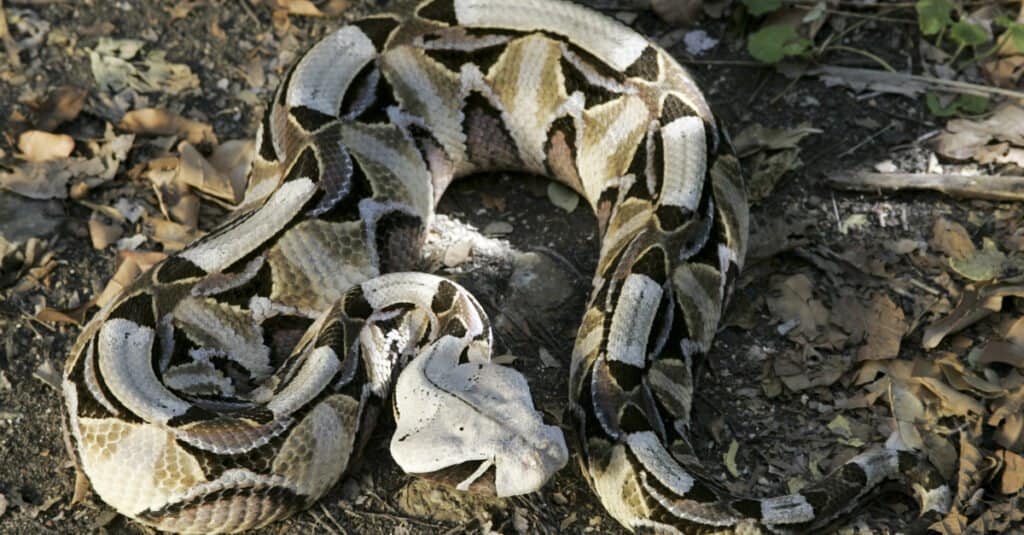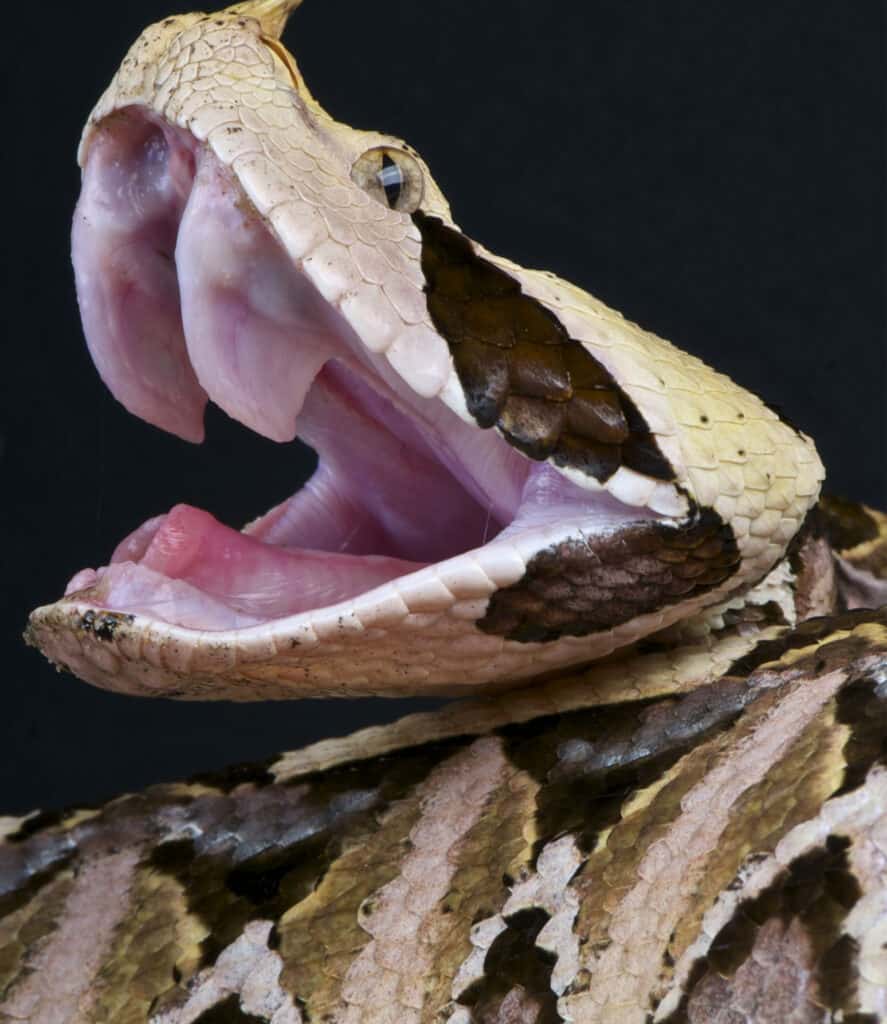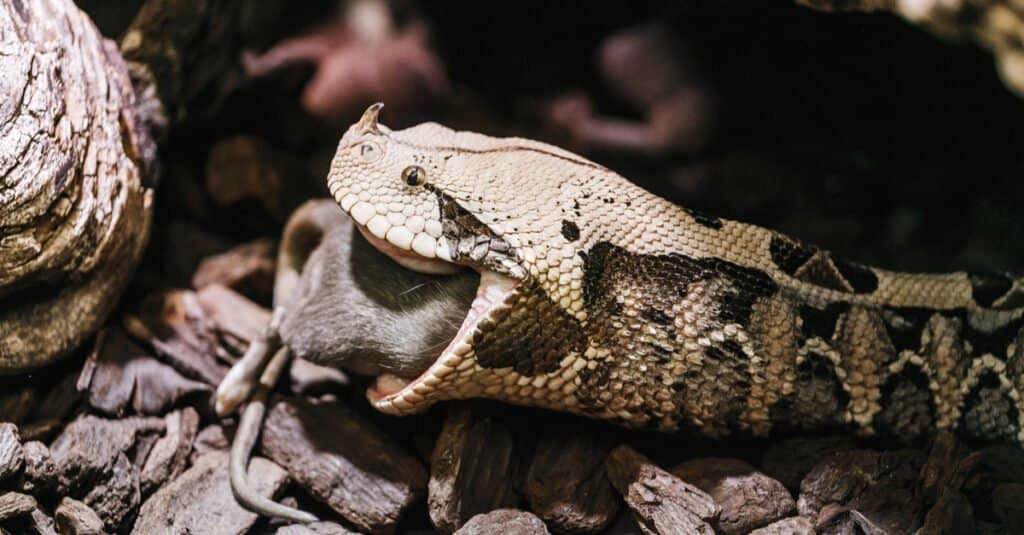Chances are, you probably haven’t heard of Gaboon viper fangs. Despite having the largest fangs of any snake in the world, the Gaboon viper is little known outside herpetological circles. This is because, unlike flashy, famous snakes, like king cobras, boa constrictors, and Burmese pythons, Gaboon vipers are rarely seen. These snakes dwell in the deepest rainforests of central Africa, happily eating a steady diet of small and medium-sized mammals. Gaboon vipers are some of the deadliest snakes on the planet, but they seldom come into contact with people.
Here, we’ll discover all there is to know about Gaboon viper fangs. We’ll start by getting to know the Gaboon viper a little better. Then, we’ll learn about their fangs, and just why they get so big. Finally, we’ll take a look at Gaboon viper venom, and what makes it so deadly.
Gaboon Viper Profile

The Gaboon viper is one of over 150 species of viper throughout the world.
©Danita Delimont/Shutterstock.com
Gaboon vipers are African snakes, they’re not found anywhere else on Earth. They have some of the most intricate patterns of any snake, which makes them incredibly hard to spot on the forest floor. Gaboon viper fangs are the longest fangs of any snake, including those much longer and heavier than them. These snakes hunt only at night, and infrequently bite humans. The Gaboon viper has incredibly potent venom; bites often lead to serious complications and even death.
Location and Habitat
Gaboon vipers live in central and western Africa. They’ve been seen in Togo, Sierra Leone, Cote D’Ivorie, Guinea, Ghana, Liberia, and more. They live primarily in rainforests but are also incidental in savannahs. Thanks to their diet, Gaboon vipers also take up residence in agricultural areas with plenty of rodents.
Unlike other, lighter, species of snake, like the green mamba, the Gaboon viper does not climb trees. Instead, they spend their entire lives on the forest floor, blending in with the leaf litter. Gaboon vipers are actually so heavy that climbing is nearly impossible for them.
Appearance and Size

Gaboon vipers are some of the heaviest snakes on Earth.
©Stu Porter/Shutterstock.com
Gaboon viper fangs aren’t the only incredible thing about these snakes. They’ve also got some of the most intricate, complex patterning of any snake. Gaboon vipers have overall brown bodies, but nearly every shade of brown comes across somewhere in their scales. They have both rectangles and ‘X’ marks along their backs, accompanied by hourglass-shaped patterns of several shades of brown along their sides.
Their patterning isn’t the only remarkable thing about Gaboon vipers. Their heads are also extremely distinct. They’re very large and very wide. Like all pit vipers, they have heat-sensing pits near their nostrils and vertically elliptical eyes. Also, they have large venom glands located just behind their eyes. As if Gaboon vipers weren’t unique enough, they also have elongated scales on their noses that look like twin horns.
Behavior
Gaboon vipers are nocturnal ambush predators. At night, they lie in wait, completely camouflaged in the dead leaves or grasses on the ground. When a small mammal, like a rat, mouse, hare, rabbit, porcupine, or Gambian pouched rat, runs by, they strike. Gaboon viper fangs are exceedingly long; they’re capable of pumping a lethal amount of venom into the prey in less than a second.
Gaboon Viper Fangs

Gaboon vipers are pit vipers, which means they have very large fangs.
©reptiles4all/Shutterstock.com
When it comes to snake teeth, there are several different varieties. Gaboon viper fangs are known as solenoglyphous, which essentially means they’re not to be messed with. All pit vipers are solenoglyphous, i.e.—large fanged, and venomous. Gaboon vipers have two rows of small, backwards pointing teeth on the roof of their mouth. But the big showstoppers are the two inch long fangs located at the front of the mouth.
Gaboon viper fangs are so long that they actually fold back when they close their mouths, like a switchblade knife. They don’t retract, like a cat’s claws. When the Gaboon viper is laying in ambush, the fangs lay flat against the roof of the mouth. But, when it strikes, all two inches of the fangs extend and penetrate. Like the back teeth, they’re recurved, so there’s no chance of the prey slipping away.
Why Are Gaboon Viper Fangs so Big?
Out of all the types of snakes in the world, pit vipers generally have the largest fangs. Among pit vipers, Gaboon viper fangs rule. But, just why are their fangs so big? Studies suggest that Gaboon viper fangs grew to their monstrous size as a way to more effectively incapacitate and kill their favorite prey—small mammals.
The larger the venomous snake’s fangs, the better chance they have at successfully envenomating their prey. And, the more successful strikes they make, the longer they live, and the more babies they make. So, over time, snakes with bigger fangs disproportionately pass on their big fang genes, leading to future generations of big-fanged snakes.
Gaboon Viper Venom

The Gaboon viper has venom toxic enough to kill a human.
©frantic00/Shutterstock.com
Since Gaboon vipers live mainly in uninhabited forests, come out only at night, and have generally docile dispositions, bites are rare. Often, it takes a person actually stepping on them for the Gaboon viper fangs to sink in. Many of the bites that do occur happen when people intentionally attempt to handle these gentle, yet deadly, snakes.
Gaboon viper bites are always a medical emergency. Their hemotoxic venom is potent enough to immediately affect the body’s primary systems. This can quickly lead to death if left untreated. Locally, the area of the bite undergoes significant swelling, and the tissue around the bite generally turns necrotic. Fatalities from Gaboon viper bites are not unheard of, but, with prompt antivenom and emergency medical care, the victim can be treated.
The photo featured at the top of this post is © Danita Delimont/Shutterstock.com
Discover the "Monster" Snake 5X Bigger than an Anaconda
Every day A-Z Animals sends out some of the most incredible facts in the world from our free newsletter. Want to discover the 10 most beautiful snakes in the world, a "snake island" where you're never more than 3 feet from danger, or a "monster" snake 5X larger than an anaconda? Then sign up right now and you'll start receiving our daily newsletter absolutely free.
Thank you for reading! Have some feedback for us? Contact the AZ Animals editorial team.






